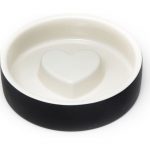How to choose the correct collar for your dog
Today there are many styles of collars to choose from. Choosing a style depends on the size and personality of your dog, and the expectation that you have for training your dog. For most breeds of dogs, a traditional nylon or leather dog collar will be more than enough. There can be specific situations that require a specialized collar and those types and styles are described below.
Standard Dog Collars- Standard (traditional) dog collars come in many styles, colors, widths, and lengths. The collar should sit high on your pet’s neck. Your dog should not have a collar that is too loose and will slide down to the dog’s shoulders. You should be easily able to fit two fingers under the collar, but the collar should not be too loose so that it can slide over your dog’s head. This is mainly for various safety reasons. Your dog should never have a collar that is tight enough to cause it to choke or cough or restrict breathing. Puppies should have the fit of their collar checked regularly as they grow very quickly and a collar may soon become too small. Full grown dogs do have this problem unless they experience rapid weight gain.
The general rule of thumb is to measure your dog’s neck where the collar should go with a soft tape measure and then add two to three inches. Also you follow the basic rule of choosing a collar that matches the size of your dog. You wouldn’t normally put a two inch wide collar on a Lhasa Apso or 3/8 inch wide collar on a Rottweiler.
Halter-type Dog Collars- This type of collar will give you the best control over your dog in most situations. The best control of a dog comes when you have control of its head. The halter-type collar fits over the dogs head so it is the best choice for control. Halter-type collars strongly resemble the same type of halter that a horse would wear, with a band going around the back of the head, and another around the snout. The leash fastens to the collar under the dog’s chin. Pulling on the leash causes the dog’s head to either be pulled down or to the side and this makes it almost impossible for the dog to pull you forward or move ahead. Halti is probably the best know manufacturer of this type of collar, but there are many others available including Gentle Leader.
Harnesses- For dogs that have problems breathing or problems with their throat should be controlled by using a harness style collar. Harnesses go around the neck and around the shoulders behind the front legs. If a dog with a neck worn collar pulls on the leash, it places pressure on the throat and neck which can cause discomfort, coughing or potentially worsening an existing injury. Harnesses prevent that type of pressure.
Pronged Collars- Pronged Collars are also referred to as pinch collars. They have blunt prongs that stick inward to the dog’s neck from the links of the collar. These are mainly designed for only the most stubborn ‘leash pullers’. Typically they are used as a temporary training tool made to change the behavior on dogs that do not respond to any other type of collar.
Choke Collars- Choke collars can also be referred to as Chain-slip collars or Choke Chains. They provide effective training and correction when used properly. They should only be used on appropriate dogs. Most often this style of collar is used on dogs that are stubborn and tend to pull when on a leash. Dogs that don’t usually respond to training when wearing traditional collars are also good candidates for the Choke collar. The Choke collar doe not actually choke the dog, but rather when used correctly it presses on a muscle in the dog’s neck that is similar to a human ‘funny bone’ so it quickly gets the dogs attention.
For correct sizing, measure your pet’s neck with a soft tape measure and then add two to three inches to get the proper length required. Also, there is a correct and incorrect way to put a choke collar on a dog. If it forms the number 9, it is on backward and may not release right away as it is supposed to, which may cause the dog discomfort, injury or gagging. To properly place a choke collar on a dog, the top ring forms a letter P when you stand in front of the dog and pull it.
You should have someone who is very familiar with the proper use of a Choke collar show you how to use it the right way. The correct way to use one involves a quick ‘snap'(tug-and-release) action (as opposed to pulling and not letting up) that tells the dog you want a different behavior. These collars should only be worn during training sessions and never in a crate or pen as they may get caught on the enclosure and choke the dog. They should also be avoided in pets with delicate throats, such as Yorkshire Terriers.
Whatever choice you make for you dog, you must consider your training needs and ultimately the safety of your dog.


